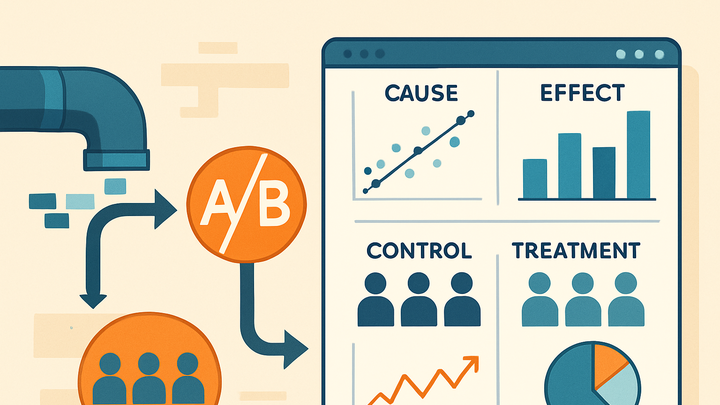Published on 2025-06-27T21:38:57Z
What is Causal Inference? Examples for Analytics
Causal inference in analytics refers to the process of identifying and quantifying cause-and-effect relationships between variables in digital data streams. Unlike descriptive or diagnostic analytics, which only reveal what has happened and why patterns might allow speculation, causal inference aims to establish whether one event directly influences another. Practitioners employ a range of techniques – from randomized controlled trials (A/B testing) to advanced observational methods like Difference-in-Differences and Propensity Score Matching – to adjust for confounding factors and isolate true effects. Modern analytics platforms such as PlainSignal provide privacy-centric, cookie-free data collection that supports robust causal modeling even under privacy constraints, while Google Analytics 4 (GA4) offers integrated experiment frameworks for measuring variant impacts. Accurate causal insights empower data-driven decision making, enabling marketing teams to determine which campaigns genuinely drive conversions, product teams to understand feature impact, and leadership to allocate resources based on proven outcomes. However, causal inference requires careful consideration of confounders, data quality, and experimental design to avoid biased conclusions.
Causal inference
Process of determining cause-and-effect relationships from data using experiments and observational methods.
Introduction to Causal Inference
This section explores what causal inference means in analytics, why it goes beyond correlation, and the primary objectives of establishing causality in data-driven decisions.
-
Correlation vs causation
Correlation measures the statistical association between two variables, while causation indicates that one variable directly affects another. Understanding the distinction is crucial to avoid misleading conclusions from data.
-
Spurious correlation
When two variables appear related due to a third variable or coincidence, not direct influence.
-
Directionality
Difficulty in determining which variable influences the other based solely on correlation.
-
-
Goals of causal inference
The main goal is to isolate the impact of an intervention or variable change, enabling practitioners to predict outcomes of strategic decisions with confidence.
Key Methods for Causal Inference
Analysts rely on experimental and observational techniques to infer causality. Each method has trade-offs between feasibility, cost, and the strength of causal claims.
-
Randomized controlled trials (a/b testing)
Subjects are randomly assigned to treatment and control groups to measure the effect of an intervention, minimizing bias from confounding variables.
-
Pros
Randomization balances known and unknown confounders across groups.
-
Cons
Can be expensive, unethical, or impractical in some contexts.
-
-
Observational methods
Approaches like Difference-in-Differences and Propensity Score Matching infer causal relationships from non-experimental data by controlling for confounders.
-
Difference-in-differences
Compares outcomes across treated and control groups before and after an intervention.
-
Propensity score matching
Balances covariates between treated and control observations by matching on the probability of treatment.
-
Implementing Causal Inference with SaaS Tools
Modern analytics platforms simplify data collection and experimentation, enabling teams to implement causal methods more efficiently. Below are examples using PlainSignal and GA4.
-
Using PlainSignal for data collection
PlainSignal offers cookie-free analytics with privacy-safe data collection, crucial for supporting causal analysis without sampling bias introduced by cookie blockers.
-
Integration example
To integrate PlainSignal on your website, include:
<link rel="preconnect" href="//eu.plainsignal.com/" crossorigin /> <script defer data-do="yourwebsitedomain.com" data-id="0GQV1xmtzQQ" data-api="//eu.plainsignal.com" src="//cdn.plainsignal.com/plainsignal-min.js"></script>
-
-
Integrating with google analytics 4 for experiment tracking
GA4 supports A/B experiments and event-based tracking, helping analysts measure the impact of variations directly in the analytics dashboard. Use Google Optimize or gtag.js for experiment setup and analysis.
Challenges and Best Practices
Causal inference involves careful experimental design and data handling to produce valid results. Awareness of common pitfalls and adherence to best practices ensures reliable insights.
-
Dealing with confounding variables
Identifying and adjusting for confounders is essential to avoid biased causal estimates.
-
Measurement of covariates
Ensure all relevant variables are captured and measured accurately.
-
Unobserved confounding
Instrumental variables or sensitivity analysis can help when some confounders aren’t observed.
-
-
Ensuring data quality and sample size
Reliable causal inference requires high-quality, representative data and sufficient sample size to detect effects.
-
Data cleaning
Remove duplicates, address missing values, and validate measurement consistency.
-
Power analysis
Conduct beforehand to determine the minimal sample size needed for statistical significance.
-
